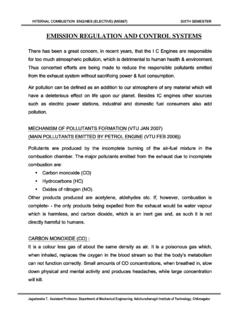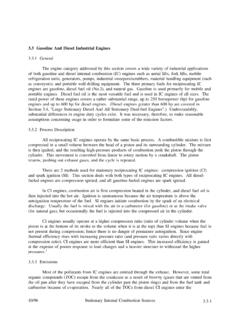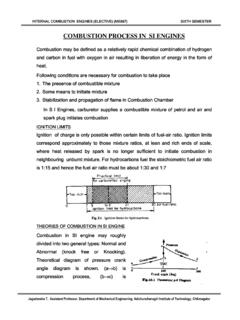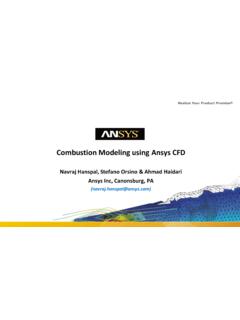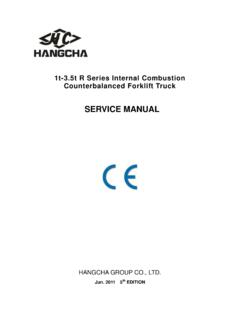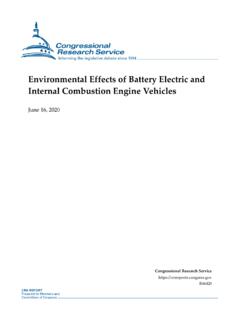Transcription of 3.2 Natural Gas-fired Reciprocating Engines
1 7/00 Stationary internal combustion Natural Gas-fired Reciprocating General1-3 Most Natural Gas-fired Reciprocating Engines are used in the Natural gas industry at pipelinecompressor and storage stations and at gas processing plants. These Engines are used to providemechanical shaft power for compressors and pumps. At pipeline compressor stations, Engines are used tohelp move Natural gas from station to station. At storage facilities, they are used to help inject the naturalgas into high pressure Natural gas storage fields. At processing plants, these Engines are used to transmitfuel within a facility and for process compression needs ( , refrigeration cycles). The size of theseengines ranges from 50 brake horsepower (bhp) to 11,000 bhp. In addition, some Engines in service are50 - 60 years old and consequently have significant differences in design compared to newer Engines ,resulting in differences in emissions and the ability to be retrofitted with new parts or pipeline compressor stations, Reciprocating Engines are used to power reciprocatingcompressors that move compressed Natural gas (500 - 2000 psig) in a pipeline.
2 These stations are spacedapproximately 50 to 100 miles apart along a pipeline that stretches from a gas supply area to the marketarea. The Reciprocating compressors raise the discharge pressure of the gas in the pipeline to overcomethe effect of frictional losses in the pipeline upstream of the station, in order to maintain the requiredsuction pressure at the next station downstream or at various downstream delivery points. The volume ofgas flowing and the amount of subsequent frictional losses in a pipeline are heavily dependent on themarket conditions that vary with weather and industrial activity, causing wide pressure variations. Thenumber of Engines operating at a station, the speed of an individual engine , and the amount of individualengine horsepower (load) needed to compress the Natural gas is dependent on the pressure of thecompressed gas received by the station, the desired discharge pressure of the gas, and the amount of gasflowing in the pipeline.
3 Reciprocating compressors have a wider operating bandwidth than centrifugalcompressors, providing increased flexibility in varying flow conditions. Centrifugal compressorspowered by Natural gas turbines are also used in some stations and are discussed in another section of thisdocument. A compressor in storage service pumps gas from a low-pressure storage field (500 - 800 psig) toa higher pressure transmission pipeline (700 - 1000 psig) and/or pumps gas from a low-pressuretransmission line (500 - 800 psig) to a higher pressure storage field (800 - 2000 psig).Storage Reciprocating compressors must be flexible enough to allow operation across a wideband of suction and discharge pressures and volume variations. The compressor must be able tocompress at high compression ratios with low volumes and compress at low compression ratios with highvolumes. These conditions require varying speeds and load (horsepower) conditions for thereciprocating engine powering the Reciprocating compressors are used at processing plants for process compression needs ( cycles).
4 The volume of gas compressed varies, but the pressure needed for the process ismore constant than the other two cases mentioned Process Description1-3 Natural Gas-fired Reciprocating Engines are separated into three design classes: 2-cycle (stroke)lean-burn, 4-stroke lean-burn, and 4-stroke rich-burn. Two-stroke Engines complete the power cycle in FACTORS7/00single crankshaft revolution as compared to the two crankshaft revolutions required for 4-stroke Engines . All Engines in these categories are a 2-stroke engine , the air-to-fuel charge is injected with the piston near the bottom of thepower stroke. The intake ports are then covered or closed, and the piston moves to the top of thecylinder, compressing the charge. Following ignition and combustion , the power stroke starts with thedownward movement of the piston. As the piston reaches the bottom of the power stroke, exhaust portsor valves are opened to exhaust, or scavenge, the combustion products, and a new air-to-fuel charge isinjected.
5 Two-stroke Engines may be turbocharged using an exhaust-powered turbine to pressurize thecharge for injection into the cylinder and to increase cylinder scavenging. Non-turbocharged enginesmay be either blower scavenged or piston scavenged to improve removal of combustion products. Historically, 2-stroke designs have been widely used in pipeline applications. However, current industrypractices reflect a decline in the usage of new 2-stroke Engines for stationary Engines use a separate engine revolution for the intake/compression cycle and thepower/exhaust cycle. These Engines may be either naturally aspirated, using the suction from the pistonto entrain the air charge, or turbocharged, using an exhaust-driven turbine to pressurize the charge. Turbocharged units produce a higher power output for a given engine displacement, whereas naturallyaspirated units have lower initial costs and require less maintenance. Rich-burn Engines operate near the stoichiometric air-to-fuel ratio (16:1) with exhaust excessoxygen levels less than 4 percent (typically closer to 1 percent).
6 Additionally, it is likely that theemissions profile will be considerably different for a rich-burn engine at 4 percent oxygen than whenoperated closer to stoichiometric conditions. Considerations such as these can impact the quantitativevalue of the emission factor presented. It is also important to note that while rich-burn Engines mayoperate, by definition, with exhaust oxygen levels as high as 4 percent, in reality, most will operatewithin plus or minus 1 air-to-fuel ratio of stoichiometry. Even across this narrow range, emissions willvary considerably, sometimes by more than an order of magnitude. Air-to-fuel ratios were not providedin the gathered emissions data used to develop the presented Engines may operate up to the lean flame extinction limit, with exhaust oxygen levelsof 12 percent or greater. The air to fuel ratios of lean-burn Engines range from 20:1 to 50:1 and aretypically higher than 24:1. The exhaust excess oxygen levels of lean-burn Engines are typically around 8percent, ranging from 4 to 17 percent.
7 Some lean-burn Engines are characterized as clean-burn term clean-burn technology is a registered trademark of Cooper Energy Systems and refers toengines designed to reduce NOx by operating at high air-to-fuel ratios. Engines operating at high air-to-fuel ratios (greater than 30:1) may require combustion modification to promote stable combustion withthe high excess air. These modifications may include a turbo charger or a precombustion chamber(PCC). A turbo charger is used to force more air into the combustion chamber, and a PCC is used toignite a fuel-rich mixture that propagates into the main cylinder and ignites the very lean combustioncharge. Lean-burn Engines typically have lower oxides of nitrogen (NOx) emissions than Emissions The primary criteria pollutants from Natural Gas-fired Reciprocating Engines are oxides ofnitrogen (NOx), carbon monoxide (CO), and volatile organic compounds (VOC). The formation ofnitrogen oxides is exponentially related to combustion temperature in the engine cylinder.
8 The otherpollutants, CO and VOC species, are primarily the result of incomplete combustion . Particulate matter(PM) emissions include trace amounts of metals, non-combustible inorganic material, and condensible,7/00 Stationary internal combustion organics which result from volatized lubricating oil, engine wear, or from products ofincomplete combustion . Sulfur oxides are very low since sulfur compounds are removed from naturalgas at processing plants. However, trace amounts of sulfur containing odorant are added to Natural gas atcity gates prior to distribution for the purpose of leak should be emphasized that the actual emissions may vary considerably from the publishedemission factors due to variations in the engine operating conditions. This variation is due to enginesoperating at different conditions, including air-to-fuel ratio, ignition timing, torque, speed, ambienttemperature, humidity, and other factors. It is not unusual to test emissions from two identical Engines inthe same plant, operated by the same personnel, using the same fuel, and have the test results showsignificantly different emissions.
9 This variability in the test data is evidenced in the high relativestandard deviation reported in the data Nitrogen Oxides -Nitrogen oxides are formed through three fundamentally different mechanisms. The principalmechanism of NOx formation with Gas-fired Engines is thermal NOx. The thermal NOx mechanismoccurs through the thermal dissociation and subsequent reaction of nitrogen (N2) and oxygen (O2)molecules in the combustion air. Most NOx formed through the thermal NOx mechanism occurs in high-temperature regions in the cylinder where combustion air has mixed sufficiently with the fuel to producethe peak temperature fuel/air interface. The second mechanism, called prompt NOx, occurs through earlyreactions of nitrogen molecules in the combustion air and hydrocarbon radicals from the fuel. PromptNOx reactions occur within the flame and are usually negligible compared to the level of NOx formedthrough the thermal NOx mechanism. The third mechanism, fuel NOx, stems from the evolution andreaction of fuel-bound nitrogen compounds with oxygen.
10 Natural gas has negligible chemically boundfuel nitrogen (although some molecular nitrogen is present). Essentially all NOx formed in Natural Gas-fired Reciprocating Engines occurs through the thermalNOx mechanism. The formation of NOx through the prompt NOx mechanism may be significant onlyunder highly controlled situations in rich-burn Engines when the thermal NOx mechanism is suppressed. The rate of NOx formation through the thermal NOx mechanism is highly dependent upon thestoichiometric ratio, combustion temperature, and residence time at the combustion temperature. Maximum NOx formation occurs through the thermal NOx mechanism near the stoichiometric air-to-fuelmixture ratio since combustion temperatures are greatest at this air-to-fuel Carbon Monoxide and Volatile Organic Compounds -CO and VOC emissions are both products of incomplete combustion . CO results when there isinsufficient residence time at high temperature to complete the final step in hydrocarbon oxidation.












